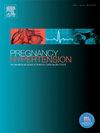Stage I hypertension and pregnancy: Scope of disease and pregnancy outcomes
IF 2.9
4区 医学
Q2 OBSTETRICS & GYNECOLOGY
Pregnancy Hypertension-An International Journal of Womens Cardiovascular Health
Pub Date : 2025-05-21
DOI:10.1016/j.preghy.2025.101222
引用次数: 0
Abstract
Objective
To compare the rates of preeclampsia between obstetric patients with stage I hypertension and those who are normotensive. Secondary aims include identifying risk factors for preeclampsia within the stage I hypertension cohort and comparing the rates of other adverse pregnancy outcomes between cohorts.
Study design
We conducted a retrospective cohort study of individuals who delivered from January 1, 2019 to July 31, 2019, at a single academic center. Patients were assigned to cohorts comprised of normotensive pregnant patients and those with stage I hypertension prior to 20 weeks gestation. Stage I hypertension is defined as a systolic blood pressure of 130–139 mmHg, a diastolic blood pressure of 80–89 mmHg, or both. Differences in outcomes were evaluated using t- tests and logistic regression models.
Results
A total of 540 patients were included, 68 of whom were identified as having stage I hypertension. Among patients with stage I hypertension in pregnancy, 19 % developed preeclampsia compared to 10 % of normotensive patients (Odds Ratio (OR) = 2.14; p = 0.028). The odds of gestational diabetes (OR = 2.65, p = 0.01) and gestational hypertension (OR = 7.99, p < 0.001) were also increased in the stage I hypertension cohort. Of the patients with stage I hypertension, a history of gestational diabetes was the only risk factor associated with subsequent development of preeclampsia (OR = 7.95, p = 0.034).
Conclusion
In our cohort, stage I hypertension prior to 20 weeks was associated with a significant increased rate of preeclampsia, gestational hypertension and gestational diabetes compared to normotensive patients.
I期高血压与妊娠:疾病范围和妊娠结局
目的比较产科I期高血压患者与血压正常者先兆子痫的发生率。次要目的包括确定I期高血压队列中子痫前期的危险因素,并比较队列之间其他不良妊娠结局的发生率。研究设计我们在一个学术中心对2019年1月1日至2019年7月31日分娩的个体进行了回顾性队列研究。患者被分配到由血压正常的孕妇和妊娠20周前患有I期高血压的患者组成的队列中。I期高血压定义为收缩压130 - 139mmhg,舒张压80 - 89mmhg,或两者兼而有之。使用t检验和逻辑回归模型评估结果的差异。结果共纳入540例患者,其中ⅰ期高血压患者68例。在妊娠期I期高血压患者中,19%的患者发生先兆子痫,而血压正常的患者为10%(优势比(OR) = 2.14;p = 0.028)。妊娠期糖尿病(OR = 2.65, p = 0.01)和妊娠期高血压(OR = 7.99, p <;在I期高血压队列中也增加了0.001)。在I期高血压患者中,妊娠糖尿病史是与子痫前期发展相关的唯一危险因素(OR = 7.95, p = 0.034)。在我们的队列中,与正常妊娠患者相比,20周前的I期高血压与先兆子痫、妊娠期高血压和妊娠期糖尿病的发生率显著增加相关。
本文章由计算机程序翻译,如有差异,请以英文原文为准。
求助全文
约1分钟内获得全文
求助全文
来源期刊

Pregnancy Hypertension-An International Journal of Womens Cardiovascular Health
OBSTETRICS & GYNECOLOGYPERIPHERAL VASCULAR-PERIPHERAL VASCULAR DISEASE
CiteScore
4.90
自引率
0.00%
发文量
127
期刊介绍:
Pregnancy Hypertension: An International Journal of Women''s Cardiovascular Health aims to stimulate research in the field of hypertension in pregnancy, disseminate the useful results of such research, and advance education in the field.
We publish articles pertaining to human and animal blood pressure during gestation, hypertension during gestation including physiology of circulatory control, pathophysiology, methodology, therapy or any other material relevant to the relationship between elevated blood pressure and pregnancy. The subtitle reflects the wider aspects of studying hypertension in pregnancy thus we also publish articles on in utero programming, nutrition, long term effects of hypertension in pregnancy on cardiovascular health and other research that helps our understanding of the etiology or consequences of hypertension in pregnancy. Case reports are not published unless of exceptional/outstanding importance to the field.
 求助内容:
求助内容: 应助结果提醒方式:
应助结果提醒方式:


